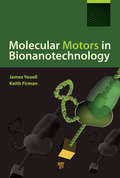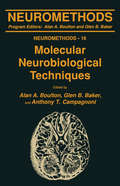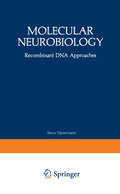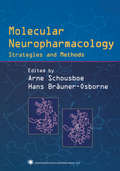- Table View
- List View
Molecular Methods for Microbial Identification and Typing
by K.J. Towner A. CockayneThe accurate identification and typing of microbes is essential for workers active in all fields of microbiology. Many examples of modern molecular methods have been concealed in scientific and medical literature but this introductory text considers the possible applications of such methods and compares their advantages and disadvantages.
Molecular Mimicry: Cross-Reactivity Between Microbes and Host Proteins as a Cause of Autoimmunity (Current Topics in Microbiology and Immunology #145)
by Michael B. A. OldstoneThis volume focuses on the evidence for or against molecular mimicry as a cause of autoimmunity. Contributions from recognized experts present their original findings, and the final chapter reviews the overall perspective of molecular mimicry, how to use its principles in clinical investigation and list the conceptual traits by which autoimmune disaese can occur.
Molecular Mimicry: Infection Inducing Autoimmune Disease (Current Topics in Microbiology and Immunology #296)
by Michael B. A. OldstoneMolecular Modeling and Prediction of Bioactivity
by Klaus Gundertofte Fleming Steen JørgensenMuch of chemistry, molecular biology, and drug design, are centered around the relationships between chemical structure and measured properties of compounds and polymers, such as viscosity, acidity, solubility, toxicity, enzyme binding, and membrane penetration. For any set of compounds, these relationships are by necessity complicated, particularly when the properties are of biological nature. To investigate and utilize such complicated relationships, henceforth abbreviated SAR for structure-activity relationships, and QSAR for quantitative SAR, we need a description of the variation in chemical structure of relevant compounds and biological targets, good measures of the biological properties, and, of course, an ability to synthesize compounds of interest. In addition, we need reasonable ways to construct and express the relationships, i. e. , mathematical or other models, as well as ways to select the compounds to be investigated so that the resulting QSAR indeed is informative and useful for the stated purposes. In the present context, these purposes typically are the conceptual understanding of the SAR, and the ability to propose new compounds with improved property profiles. Here we discuss the two latter parts of the SARlQSAR problem, i. e. , reasonable ways to model the relationships, and how to select compounds to make the models as "good" as possible. The second is often called the problem of statistical experimental design, which in the present context we call statistical molecular design, SMD. 1.
Molecular Modelling and Drug Design (Topics in Molecular and Structural Biology)
The place of molecular modelling in drug design is now firmly established. Molecular Modelling and Drug Design contains chapters from among the best young scientists in industry and academia. They present many of the new methods available as well as describing the correct use of more established techniques. The book has been written with a blend of optimism, including methods designed to semi - automate a large part of the drug design process, and pragmatism, pointing out the traps into which the unwary researcher may be drawn. Essential reading both for the modelling practitioner, and for those whose research would benefit from an understanding of the broad range of applications of molecular modelling.
Molecular Modelling of Vitamin B12 and Its Analogues
by Penny Govender Francis Opoku Olaide Wahab Ephraim KiariiFor many years, the chemistry of vitamin B12 and its derivatives has been investigated for their inherent eco-friendly and nontoxic nature. This vitamin, also known as cobalamin, is an organic complex that contains a cobalt ion in its structure. Its derivatives are vital bio-inorganic cofactors and possess complex and rich photolytic properties, facilitated by their excited states. This book compiles and details cutting-edge research in the application of vitamin B12 as an environmentally benign catalyst for several organic reactions. It discusses the recent advances and current understanding of the photolytic properties of vitamin B12 derivatives from the perspective of the density functional theory (DFT). The book is of interest for anyone involved in nanotechnology, macromolecular science, cancer, and drug-delivery research.
Molecular Modelling of Vitamin B12 and Its Analogues
by Penny Govender Francis Opoku Olaide Wahab Ephraim KiariiFor many years, the chemistry of vitamin B12 and its derivatives has been investigated for their inherent eco-friendly and nontoxic nature. This vitamin, also known as cobalamin, is an organic complex that contains a cobalt ion in its structure. Its derivatives are vital bio-inorganic cofactors and possess complex and rich photolytic properties, facilitated by their excited states. This book compiles and details cutting-edge research in the application of vitamin B12 as an environmentally benign catalyst for several organic reactions. It discusses the recent advances and current understanding of the photolytic properties of vitamin B12 derivatives from the perspective of the density functional theory (DFT). The book is of interest for anyone involved in nanotechnology, macromolecular science, cancer, and drug-delivery research.
Molecular Morphology in Human Tissues: Techniques and Applications
by Gerhard W. Hacker Raymond R. TubbsMolecular Morphology in Human Tissues: Techniques and Applications presents the most advanced molecular morphological techniques to date. This integrated approach to molecular morphology provides powerful analytical and diagnostic tools at the genome level, making the diagnosis and management of cancer, viral infections, and other diseases more pre
Molecular Motors in Bionanotechnology
by Keith FirmanBiological molecular motors provide most cells with the dynamic systems required for their day-to-day existence. Examples occur in even the simplest organism (e.g. a bacteria virus), and the range of tasks that they carry out is vast. Over the last few years, there has been a large increase in the study of these motors, and it is becoming apparent
Molecular Neuro-oncology and Its Impact on the Clinical Management of Brain Tumors (Recent Results in Cancer Research #135)
by J. Schramm U. Schlegel O. D. WiestlerMolecular Neurobiological Techniques (Neuromethods #16)
by Alan A. Boulton, Glen B. Baker and Anthony T. CampagnoniIt goes without saying that the principles and techniques of molecular biology are having and will continue to have a major impact on investigations into nervous system structure and func tion. It is becoming increasingly apparent to neuroscientists in all subdisciplines that a working knowledge of the language, approaches, and techniques of molecular biology is indispensable for their work. For these reasons, the editors have decided to devote this volume of Neuromethods to the techniques of molecular biology and their application to neural systems. There currently exist a number of excellent reference technical manuals that de scribe molecular neurobiological techniques in great detail, and many of these are cited within the chapters included in this volume. It was not the intention of the editors or authors of this volume to duplicate these efforts. Rather, our intention was to present to the neuroscientist who is relatively unfamiliar with these methodologies an understanding of how specific techniques are used to approach major molecular neurobiological problems as well as a set of techniques that work in the laboratories of the individuals writing the chapters. In some cases, there are duplica tions of techniques these have been retained to illustrate the range of variability of the technique and/or the flexibility of the method to study different types of problems. We hope that the chapters will provide the reader with an understanding of the methods and their applicability to neurobiological problems; and, perhaps, suggest new directions for the reader's research efforts. Anthony T.
Molecular Neurobiology: Recombinant DNA Approaches (Current Topics in Neurobiology)
by Steve Heinemann James PatrickThis book is a collection of papers describing some of the first attempts to apply the techniques of recombinant DNA and molecular biology to studies of the nervous system. We believe this is an important new direction for brain research that will eventually lead to insights not pos sible with more traditional approaches. At first glance, the marriage of molecular biology to brain research seems an unlikely one because of the tremendous disparity in the histories of these two disciplines and the problems they face. Molecular biology is by nature a reductionist approach to biology. Molecular biologists have always tried to attack central questions in the most direct approach possible, usually in the most simple system available: a bacterium or a bacterial virus. Important experiments can usually be repeated quickly and cheaply, in many cases by the latest group of graduate students entering the field. The success of molecular biology has been so profound because the result of each important experiment has made the next critical question obvious, and usually answerable, in short order. Studies of the nervous system have a very different history. First, the human brain is what really interests us and it is the most complex structure that we know in biology. The central question is clear: How do we carry out higher functions such as learning and thinking? How ever, at present there is no widely accepted and testable theory of learn ing and no clear path to such a theory.
Molecular Neurobiology of Addiction Recovery: The 12 Steps Program and Fellowship (SpringerBriefs in Neuroscience)
by Kenneth Blum John Femino Scott Teitelbaum John Giordano Marlene Oscar-Berman Mark GoldHumans are biologically programmed to seek out pleasurable experiences. These experiences are processed in the mesolimbic system, also referred to as the "reward center" of the brain, where a number of chemical messengers work in concert to provide a net release of dopamine in the Nucleus Accumbens. In some genetically predisposed individuals, addiction occurs when the mechanisms of the mesolimbic system are disrupted by the use of various drugs of abuse. Since Alcoholics Anonymous was founded in 1935, it's 12 step program of spiritual and character development has helped countless alcoholics and drug addicts curb their self-destructive behaviors. However, the program was developed at a time when comparatively little was known about the function of the brain and it has never been studied scientifically. This is the first book to take a systematic look at the molecular neurobiology associated with each of the 12 steps and to review the significant body of addiction research literature that is pertinent to the program.
Molecular Neurobiology of the Olfactory System: Molecular, Membranous, and Cytological Studies
by F. L. Margolis T. V. GetchellThe sense of smell and the olfactory system have been a subject of intrinsic interest for millenia. Inquiry into the structure and function of the olfactory system is based on a long tradition that dates back at least to the ancient Greeks. The mechanistic basis for the sensitivity and selectivity of this chemosensory detection system has always posed a challenge and remained largely a mystery. Recently, there has been a renaissance of interest in it and especially in the application of contemporary techniques of biochemistry and cellular and molecular biology. In this volume, current research utilizing these ap proaches is discussed in depth by a group of scientists who are among the current leaders in the applications of these techniques to the olfactory system. These authors address a wide range of questions that bear directly on the olfactory system but have broader biological implications as well. The various chapters have been grouped into five broad subject areas that emphasize diverse but related questions. "Transduction and Ligand-Receptor Interactions" considers the biochemical bases of stimulus access, interaction, transduction, elimination, and information processing.
Molecular Neuropharmacology: Strategies and Methods
by HansBräuner-Osborne ArneSchousboeA powerful collection of readily reproducible cutting-edge techniques for characterizing the ligand or substrate binding of neurotransmitter receptors and transporters. The procedures cover interdisciplinary interactions for monoamine transporters, amino acid transporters, ionotropic receptors, metabotropic glutamate receptors, GABA receptors, and other G protein-coupled receptors. By illuminating how neurons in the central nervous communicate with other, these techniques can lead to the development of novel therapeutic strategies for neurological diseases.
Molecular Neurosurgery with Targeted Toxins
by Ronald G. Wiley Douglas A. LappiPioneers and leading researchers explain the theory and techniques of using targeted toxins experimentally. The highly successful use of the 192 IgG-saporin and ME20.4-saporin immunotoxins to lesion the cholinergic basal forebrain in order to model the behavior, anatomy, physiology, and pharmacology of Alzheimer's disease in animals is treated in detail to give a potential user the knowledge to comfortably use the techniques involved. The uses of important new lesioning agents such as anti-DBH-saporin immunotoxin to make remarkably selective lesions of catecholaminergic neurons, hypocretin-saporin that can produce narcoleptic animals, and other saporin conjugates, such as neuropeptide-saporin conjugates for pain research and cholera toxin B chain-saporin to produce a model of CNS demyelination are explained by experts in the field.
Molecular Neurovirology: Pathogenesis of Viral CNS Infections
by Raymond P. RoosNeurovirology, the study of viral infection of the ner vous system, has evolved at the interface of three of the most rapidly unfolding fields of investigation-neurobiology, vi rology, and immunology. In all three, increasing knowledge about the molecular structure of surface receptors, how in tracellular messages are transmitted, and how diversity is regulated genetically is provided, along with the techniques of molecular biology. This promises to give us knowledge not only about the process of infection and the complex host and viral determinants of neuroinvasiveness and neurovirulence, but eventually it will provide the background from which to engineer vaccines and to devise novel therapeutic agents. Animal virology and molecular biology developed quite independently from different origins. Animal virology was originally the province of the pathologists, and by clinical observation and histological preparations, they tried to ex plain the incubation period, the pathways of virus spread, and the mechanisms of disease. Molecular virology grew out of biochemistry, particularly through studies of bacterio phage, with emphasis on the physical and chemical structure of viruses and the sequences of biochemical events during the replicative cycle in cells.
Molecular Nuclear Medicine: The Challenge of Genomics and Proteomics to Clinical Practice
by L. E. Feinendegen W. W. Shreeve W. C. Eckelman Yong-Whee Bahk H. N. Jr. WagnerBiochemical transparency of the human body is at the doorstep of advanced technology. Toward this goal the book describes relevant isotopic tracer techniques of nuclear medicine. It deals with quantitatively measuring in vivo biochemical reactions as they occur within homeostatic circuits under control by genes and protein interactions. The text indicates how nuclear medicine can aid clinical researchers and practitioners, human geneticists and pharmacologists in understanding (and affecting) gene-phenotype relationships. Experts give background, techniques and examples in an interdisciplinary approach to regional imaging and in vitro analyses of biochemical reactions.
Molecular Nutrition and Genomics: Nutrition and the Ascent of Humankind
by Mark LucockThis fascinating book draws it subject matter from a range of relevant disciplines that extend from molecular nutrition, nutritional sciences, and nutrition dietetics through to genetics, genomics, and anthropology. It presents a vital portrait of the absolutely fundamental role that nutrition has played and continues to play in shaping who and what human beings are, as well as where they evolved from, and where they may be heading as a species. Molecular Nutrition: Nutrition and the Evolution of Humankind: Blends coverage of the molecular mechanisms that underpin nutrient-gene interactions with evolutionary theory Takes a molecular biological approach to problem solving, and moves nutrition away from its dietetic and anthropological origins to the front lines of genomic research Covers key concepts in molecular biology; the –omics revolution and bioinformatics; recent human evolution; molecular mechanisms of gene-nutrient interactions; the importance of nutrients and genomics in disease; the evolution of micronutrient metabolism, protein structure, and human disease; nutrients and the human lifecycle; contemporary dietary patterns; leading-edge laboratory tools in nutrigenomics and human evolutionary studies Written by an internationally recognised expert in the field, Molecular Nutrition: Nutrition and the Evolution of Humankind is an invaluable text and reference book for a wide range of teachers, students, and researchers.
Molecular Oncology: Underlying Mechanisms and Translational Advancements
by Ammad Ahmad Farooqi Muhammad IsmailCancer is a multifaceted and genomically complex disease and data obtained through high throughput technologies has provided near complete resolution of the landscape of how genomic, genetic and epigenetic mutations in cancerous cells effectively influence homeostasis of signaling networks within these cells, between cancerous cells, tumor microenvironment and at the organ level. Increasingly sophisticated information has helped us in developing a better understanding of the underlying mechanisms of cancer, and it is now known that intra-tumor genetic heterogeneity, cellular plasticity, dysregulation of spatio-temporally controlled signaling cascades, and loss of apoptosis are contributory in cancer development, progression and the development of resistance against different therapeutics. It is becoming progressively more understandable that earlier detection of pre-existing or emerging resistance against different therapeutics may prove to be helpful in personalizing the use of targeted cancer therapy. Despite the fact that there is a continuously increasing list of books, being guest edited by researchers, books on the subject are often composed of invited reviews without proper sequence and continuity and designed for a particular readership. This book progressively shifts and guides the readers from basic underlying mechanisms to translational approaches to treat cancer.
Molecular Oncology Testing for Solid Tumors: A Pragmatic Approach
by Michael Ola Idowu Catherine Isabelle Dumur Carleton Theodore GarrettFamiliarity with and understanding molecular testing is becoming imperative for practicing physicians, especially pathologists and oncologists given the current explosion of molecular tests for diagnostic, prognostic and predictive indications.Molecular Oncology Testing for Solid Tumors is designed to present an up to date practical approach to molecular testing in a easy to understand format. Emphasis is placed on quality assurance (pre-analytic, analytic and post-analytic) and test interpretation, including but not limited to: the important role of pathologists in ensuring specimen adequacy for molecular testing; factors to consider in choosing platforms for molecular assays; advantages and limitations inherent to common assays/platforms that pathologists need to communicate effectively with clinicians; the importance of required quality assurance measures to ensure accurate / reproducible results; pitfalls in test interpretation (including different types of artifacts that may lead to False Positive or False Negative interpretations); test reporting using standard nomenclature; review of the current and future potential utility of next-generation sequencing in oncology.All chapters are written by pathologists and clinicians experienced in practical applications of molecular tests for solid tumors. The uniqueness of this textbook is the use of a standardized template for each of the molecular tests being discussed followed by a discussion of relevant quality assurance issues to ensure focused and efficient presentation of information. This will enable readers to easily understand the Order, Report and Evaluate (ORE) process of molecular tests. Lastly, summary tables of all the molecular assays and mutations discussed in the text are provided as an appendix for quick reference. For readers interested in more detailed information, a link to websites where additional information can be obtained is provided.
Molecular Orbital Calculations for Biological Systems (Topics in Physical Chemistry)
by Anne-Marie SapseMolecular Orbital Calculations for Biological Systems is a hands-on guide to computational quantum chemistry and its applications in organic chemistry, biochemistry, and molecular biology. With improvements in software, molecular modeling techniques are now becoming widely available; they are increasingly used to complement experimental results, saving significant amounts of lab time. Common applications include pharmaceutical research and development; for example, ab initio and semi-empirical methods are playing important roles in peptide investigations and in drug design. The opening chapters provide an introduction for the non-quantum chemist to the basic quantum chemistry methods, ab initio, semi-empirical, and density functionals, as well as to one of the main families of computer programs, the Gaussian series. The second part then describes current research which applies quantum chemistry methods to such biological systems as amino acids, peptides, and anti-cancer drugs. Throughout the authors seek to encourage biochemists to discover aspects of their own research which might benefit from computational work. They also show that the methods are accessible to researchers from a wide range of mathematical backgrounds. Combining concise introductions with practical advice, this volume will be an invaluable tool for research on biological systems.
Molecular Orbital Studies in Chemical Pharmacology
by Lemont B. KierA symposium on molecular orbital studies in chemical pharmacology was held at the Battelle Seattle Research Center of Batteile Memorial Institute in Seattle, Washington, U.S.A, on October 20-22, 1969. This volume is a col lection of the lectures presented at that symposium. The use of quantum mechanics to study the actions of molecules of biological importance is being developed by a number of scientists concerned with these phenomena. The advent of high speed computers has made possible the appl i cation of this technique to large molecules, of the kind important in living systems. One result of this expanded computational abi I ity has been the uti I i zation of molecular orbital theory by a group of scientists of diverse backgrounds. The lecturers at this symposium, all interested in molecular orbital theory, have backgrounds in pharmacology, physical chemistry, theoretical chemistry, bio chemistry and medicinal chemistry. The common denominator among these scientists has been the realization that they must search at the primary level of chemical events for explanations of biological phenomena. Since these events are governed to a large extent by the properties of the valence electrons of molecules, molecular orbital theory offers great promise in explaining and predicting biological phenomena. October, 1969 Lemont B. Kier Table of Contents v Preface BERNARD PULLMAN - Electrons in Nucleic Acids and their Cons- tu ent s JAMES R. HOYLAND - Semiempirical MO Theories: A Critique and 31 a Rev i ew of Progress ••••• . •••.























